You can listen to Hoosier History Live! live on the air each Saturday, or listen online at the WICR website during the broadcast. We invite you to visit our website!
Feb. 19 show
Indianapolis City Market then and now
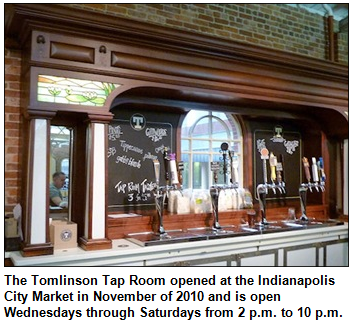 Does it seem as though evolving lifestyles and various renovations are continually upsetting the apple cart at Indianapolis City Market? With all sorts of changes brewing (or recently accomplished) - including the opening of what may be the first and only bar in the historic marketplace - Hoosier History Live! is revisiting the landmark, built in 1886.
Does it seem as though evolving lifestyles and various renovations are continually upsetting the apple cart at Indianapolis City Market? With all sorts of changes brewing (or recently accomplished) - including the opening of what may be the first and only bar in the historic marketplace - Hoosier History Live! is revisiting the landmark, built in 1886.
Nelson will be joined in studio by Jim Reilly, who became executive director of City Market in October 2008 and has overseen the opening of Tomlinson Tap Room, which serves up Indiana-brewed beers. The name of the bar, which is on the mezzanine level, is a historic salute to Tomlinson Hall, a massive civic building that adjoined City Market until it was destroyed by a raging fire in 1958.
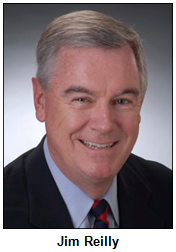 Not only will Jim share insights about the historic fire (only Tomlinson Hall's doorway arch remains, serving as the entryway to City Market's courtyard), he also has dreams for the mysterious, long-unused catacombs beneath the marketplace. Would you believe that, according to Jim, the temperature in the catacombs never dips below 50 degrees, even during bone-chilling winters like we've been enduring?
Not only will Jim share insights about the historic fire (only Tomlinson Hall's doorway arch remains, serving as the entryway to City Market's courtyard), he also has dreams for the mysterious, long-unused catacombs beneath the marketplace. Would you believe that, according to Jim, the temperature in the catacombs never dips below 50 degrees, even during bone-chilling winters like we've been enduring?
As part of the show’s "then/now" theme, Jim also will share updates on the $2.7 million renovation, which includes the $800,000 project that's planned to transform City Market's east wing into a bicycle hub with showers. He welcomes listener questions and understands the frustrations with the seemingly endless attempts to revive the historic marketplace that once bustled with generations of immigrant families who sold fresh fruit, vegetables, bakery goods, poultry and meat.
It seems like only yesterday - actually, it was 2007 - when City Market underwent a $2.5 million renovation. 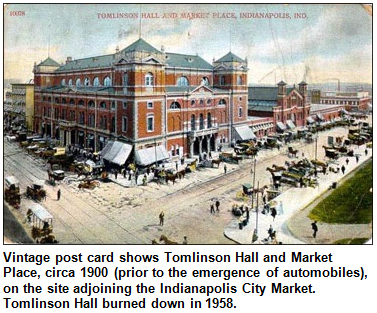 (Fun fact: In 1886, City Market was built for $29,225.) As Hoosier History Live! listeners learned when Dale Kenney, who served as market master in the 1970s was our studio guest, its site on East Market Street was an outdoor marketplace at the very beginnings of the city in the 1820s, long predating the building's construction.
(Fun fact: In 1886, City Market was built for $29,225.) As Hoosier History Live! listeners learned when Dale Kenney, who served as market master in the 1970s was our studio guest, its site on East Market Street was an outdoor marketplace at the very beginnings of the city in the 1820s, long predating the building's construction.
"As far as I know, the Tomlinson Tap Room is the first and only bar establishment to be located in the City Market, though," Jim Reilly says. "If any of your listeners have information to the contrary, I would love to know the details." Tomlinson Tap Room is a joint venture between City Market and the Brewers of Indiana Guild.
Meanwhile, the historic catacombs underneath the west plaza remain a source of intrigue. According to folklore - and a note Jim received just last week from a city resident - the catacombs may have been used more than 100 years ago by the U.S. Army to store cannon balls and gun powder. Several local historians, however, doubt that. Jim and Nelson will explain why it's unlikely. 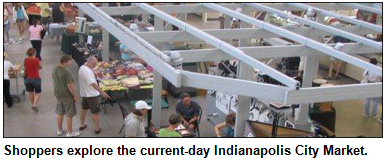 They also will welcome your "then and now" memories, insights and suggestions involving City Market during the show. Some aspects of the renovation plans for the landmark have been delayed, although new vendors are expected to open soon.
They also will welcome your "then and now" memories, insights and suggestions involving City Market during the show. Some aspects of the renovation plans for the landmark have been delayed, although new vendors are expected to open soon.
By the way, this is not Jim Reilly's first time at the rodeo. Although he wasn't at City Market during its previous renovation, he served as executive director from 1994 to 2001. A native of Pennsylvania, Jim moved to Indy in the 1970s to work for what's now Simon Property Group. He has visited urban marketplaces from Seattle to Boston.
History Mystery question
In 1886, the same year Indianapolis City Market was built, a family-owned retailer opened in downtown Indianapolis. Almost from the very beginning, the store specialized in hard-to-find sizes of the product it sold. Today, nearly 130 years later, the retailer is still open at its original site downtown. Owned and operated by descendants of its founder, the store claims to be the oldest continually operated retailer of its kind in the entire country.
Question: Name the store in downtown Indianapolis.
To win the prize, you must call in with the correct answer during the live show. The call-in number is (317) 788-3314, and the prize is a four tickets to the NCAA Hall of Champions, courtesy of the ICVA.
Roadtripper: Indy Grand Prix at the Nat
Roadtripper Chris Gahl of the ICVA tells us that swimming stars from across the country will be making waves and returning to Indianapolis March 3-5 for the Indy Grand Prix at the Nat.
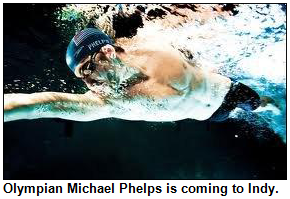 Michael Phelps will be diving in at the Indiana University Natatorium to compete in the USA Swimming Grand Prix Series against other past Olympians Ryan Lochte, Katie Hoff and Missy Franklin. Here's an opportunity to see up close the athletes we cheered to gold during the summer games.
Michael Phelps will be diving in at the Indiana University Natatorium to compete in the USA Swimming Grand Prix Series against other past Olympians Ryan Lochte, Katie Hoff and Missy Franklin. Here's an opportunity to see up close the athletes we cheered to gold during the summer games.
The Indy Grand Prix is one stop on a seven-event series. Swimmers are competing for medals and a $20,000 cash prize awarded at the end of the series.
Tickets can be purchased at www.allgreatracers.com or on-site at the Natatorium box office.
Update regarding last week's 'Songs of our ancestors' show
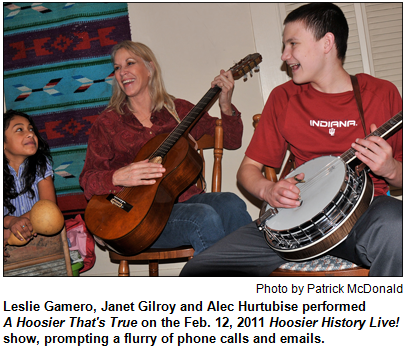 During our Feb. 12 show about "songs of our ancestors as they journeyed here," our trio of guests performed a folk tune that may have been titled A Hoosier That's True. The folk song has become at least somewhat obscure - neither Nelson nor teacher-musician Janet Gilray, author of Voices in Time - said they had heard the tune while growing up in Indiana. (Janet was alerted to the Hoosier song by a musician in California.)
During our Feb. 12 show about "songs of our ancestors as they journeyed here," our trio of guests performed a folk tune that may have been titled A Hoosier That's True. The folk song has become at least somewhat obscure - neither Nelson nor teacher-musician Janet Gilray, author of Voices in Time - said they had heard the tune while growing up in Indiana. (Janet was alerted to the Hoosier song by a musician in California.)
However, it rang a bell with many of our listeners, including some who recalled singing the tune - perhaps with a different title - at summer camp more than 60 years ago. Our faithful listener Phil Brooks of Brownsburg even sent YouTube links to renditions of it by some disparate performers, including Rosemary Clooney and, believe it or not, Bugs Bunny.
Janet and her young musician accompanists, 15-year-old banjo player Alec Hurtubise and 10-year-old vocalist Leslie Gamero, would be grateful for any other info about the folk tune, including the identify of the composer. E-mail us, and we’ll pass along the info. Meanwhile, here are the YouTube links for your listening pleasure:
http://www.youtube.com/watch?v=B5qqQWkzl-E
http://www.youtube.com/watch?v=-tIWrwSHY7M
Your team on the Hoosier History Live! e-project,
Nelson Price, host and creative director
Molly Head, producer, (317) 927-9101
Chris Gahl, Roadtripper
Richard Sullivan, webmaster and tech director
Pam Fraizer, graphic designer
Garry Chilluffo, creative consultant
www.hoosierhistorylive.org


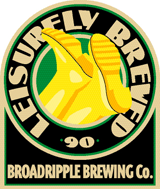

Please tell our sponsors that you appreciate their support: Broad Ripple Brewpub, Indiana Historical Society, Lucas Oil and Story Inn.
 Acknowledgments to Print Resources, Indianapolis Marion County Public Library, Monomedia, Indiana Humanities Council, Indianapolis Convention & Visitors Association, WICR-FM, Fraizer Designs, Chelsea Niccum and many other individuals and organizations. We are an independently produced program and are self-supporting through organizational sponsorships, grants and through individual tax-deductible contributions through the Indiana Humanities Council. Visit our website to learn how you can support us financially.
Acknowledgments to Print Resources, Indianapolis Marion County Public Library, Monomedia, Indiana Humanities Council, Indianapolis Convention & Visitors Association, WICR-FM, Fraizer Designs, Chelsea Niccum and many other individuals and organizations. We are an independently produced program and are self-supporting through organizational sponsorships, grants and through individual tax-deductible contributions through the Indiana Humanities Council. Visit our website to learn how you can support us financially.
Feb. 26 show
Police history in Indy
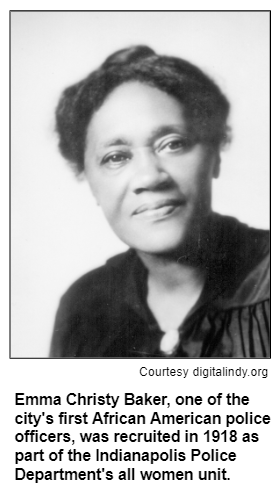 With the heroism of Indianapolis Metropolitan Police Department Officer David Moore, community-wide grief over his shooting death last month, and various controversies surrounding other members of the force, the spotlight has been on the police recently. Hoosier History Live! is seizing the moment to explore the history of an organized police force in the Hoosier capital and how it has unfolded for more than 150 years.
With the heroism of Indianapolis Metropolitan Police Department Officer David Moore, community-wide grief over his shooting death last month, and various controversies surrounding other members of the force, the spotlight has been on the police recently. Hoosier History Live! is seizing the moment to explore the history of an organized police force in the Hoosier capital and how it has unfolded for more than 150 years.
Nelson's studio guests will include Sabrina Young, vice president of the Indianapolis Police Historical and Educational Foundation. In connection with Black History Month, they will share insights about early African-American police officers - and women officers as well.
According to an account in The Indianapolis Star, trail-blazers included Emma Christy Baker, a well-known business leader in 1918 who became the first black female officer on what was then IPD. (She patrolled a downtown beat.) After some breakthroughs during the 1920s, when IPD employed the country's largest all-female unit, the department did not hire women for street patrol again until 1968.
We also will time travel much farther back, exploring perceptions during the 1840s and '50s that - because of the waves of immigrants, the arrival of railroads and battles over the propriety of alcohol consumption - the city "was in the midst of a crime wave,"
according to The Encyclopedia of Indianapolis. These fears apparently resulted in a clamor for a paid city police force.
Initially, officers were identified only by a silver star; they got blue uniforms in 1862. Historic uniforms, badges and weapons, including nun chucks once used to subdue perpetrators, will be exhibited at a police history museum under way in a historic building near Conseco Fieldhouse. Sabrina Young is an organizer of the interactive museum, which will be known as Cop City and is being privately funded. She will share details about Cop City, which is slated to open in time for Super Bowl visitors next February. In addition to focusing on IPD’s history, she says Cop City will spotlight the local heritage of other law enforcement officials such as sheriff’s deputies and FBI agents.
© 2011 Hoosier History Live! All rights reserved.